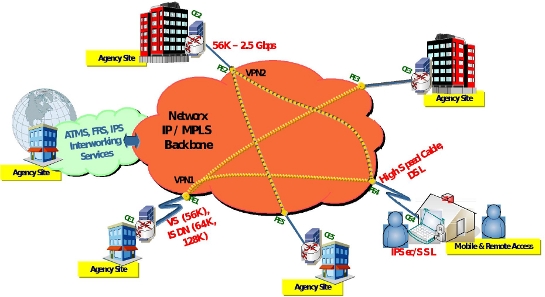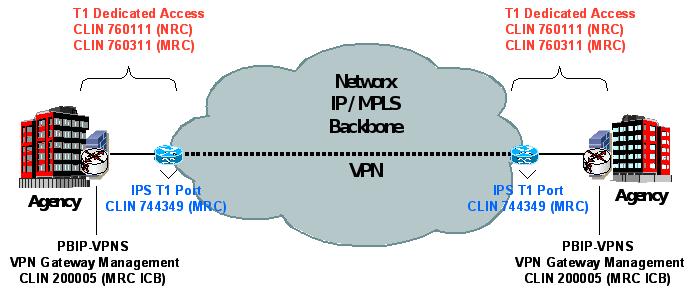PBIP-VPNS provides secure, reliable transport of Agency applications across a contractor's multiprotocol label switching (MPLS) backbone infrastructure for geographically dispersed Agency locations. The service footprint covers CONUS, OCONUS and Non-Domestic locations. PBIP-VPNS is similar to FTS2001 services such as Private IP (PIP), Multiprotocol Label Switching (MPLS), and Very high performance Backbone Network Service (VBNS).
A virtual private network (VPN) is a network that is layered on top of an underlying transport network. The private nature of a VPN derives from the implementation of the VPN in an encapsulated form that is not visible to the underlying network. Virtual paths called "tunnels" are established within the network.
The following diagram illustrates a layered architecture for PBIP-VPNS with its basic building blocks. The figure shows two independent premises-based VPNs interconnecting Agency sites with various forms of dial, broadband, and dedicated access to the contractor's network.

The basic building blocks are comprised of the following:
Note that an edge device can belong to multiple VPNs as illustrated by the PE4 device.
The PBIP-VPNS solution gives the Agency full end-to-end security control of the traffic; but carries a higher burden of capital and operational expenditure. The contractor's core MPLS infrastructure can be used to create Agency specific topologies from partially-meshed to fully-meshed networks.
The main characteristics of a premises-based VPN are:
PBIP-VPNS supports a complete set of Agency site types:
PBIP-VPNS allows Agencies to interconnect sites served by ATMS, FRS, PLS, and Ethernet services. The MPLS backbone creates virtual circuits between MPLS-enabled endpoints on the network and Agencies will receive customized PBIP-VPNS solutions that meet the Agency's specific requirements.
PBIP-VPNS features are available that include:
Basic service level agreements (SLAs) supported include:
Each Networx contractor may provide variations or alternatives to the offering and pricing for PBIP-VPNS. The specific details can be found within each Contractor's Networx contract files and pricing notes for PBIP-VPNS.
For more information on the general PBIP-VPNS specifications and requirements, please refer to Section C.2.7.2 of the Networx contract for technical specifications and Section B.2.7.2 for pricing.
PBIP-VPNS provides secure, reliable transport of Agency applications across a contractor's multiprotocol label switching (MPLS) backbone infrastructure for geographically dispersed Agency locations. Pricing for PBIP-VPNS is based on a number of factors such as number of sites, bandwidth requirements, security services, and the type of access.
PBIP-VPNS provides three basic solutions:
Price components required for full end-to-end service for Intranet and Extranet PBIP-VPNS:
Example 1: PBIP-VPNS Intranet or Extranet

For a remote access solution, two types of access arrangements are possible:
Price components required for full end-to-end service for Remote Access PBIP-VPNS:
Example 2: PBIP-VPNS Remote Access

Each Networx contractor may provide variations or alternatives to the offering and pricing for PBIP-VPNS. The specific details can be found within each Contractors Networx contract files and pricing notes for PBIP-VPNS.
For more information on the general PBIP-VPNS specifications and requirements, please refer to Section C.2.7.2 of the Networx contract for technical specifications and Section B.2.7.2 for pricing.